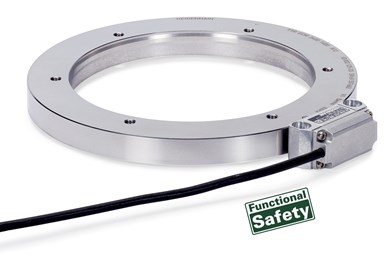Heidenhain Offers Magnetic Ring Encoder
The ECM 2400 encoder from Heidenhain is an absolute modular magnetic angle encoder that is designed to resist contamination and offer functional safety.
Share






Heidenhain introduces the ECM 2400 encoder, an absolute modular magnetic angle encoder that is designed to resist contamination and offer functional safety (FS) for machine feedback. The ECM 2400 is suitable for applications with high rotational speeds and angular accelerations. It’s low overall height makes it suitable for operations that have limited space, according to the company.
The ECM 2400 is suitable for B-axis lathes with motorized milling spindles or on the A and C axes of milling machines where a large, hollow shaft encoder is necessary. In general, it is suitable on all rotary axes that require the following attributes:
- Safety-oriented application (mechanical fault exclusion)
- Sturdy angle encoder
- Large inside diameter
- Lower position accuracy than an optical measurement system
- Dynamic positioning accuracy (simultaneous multi-axis machining)
The ECM 2400 encoders are available with EnDat 2.2 interface. In conjunction with a safe control, they can be used as single-encoder systems in applications with control category SIL 2 (per EN 61508) and with Performance Level “d” (per EN ISO 13849). Its fault exclusion has been tested and is ensured under the specified operating conditions, according to . Existing non-FS interfaces for ECM 2400 encoders include FANUC 05 and Mit03-4. All of these encoders have an IP67 rating.
Related Content
-
Ballbar Testing Benefits Low-Volume Manufacturing
Thanks to ballbar testing with a Renishaw QC20-W, the Autodesk Technology Centers now have more confidence in their machine tools.
-
How to Successfully Adopt Five-Axis Machining
While there are many changes to adopt when moving to five-axis, they all compliment the overall goal of better parts through less operations.
-
Lean Approach to Automated Machine Tending Delivers Quicker Paths to Success
Almost any shop can automate at least some of its production, even in low-volume, high-mix applications. The key to getting started is finding the simplest solutions that fit your requirements. It helps to work with an automation partner that understands your needs.
.JPG;width=70;height=70;mode=crop)












